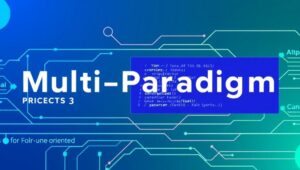The Rise of Multi-Paradigm Languages: Flexibility for the Future (2025)
In the ever-evolving landscape of software development, the choice of programming language can significantly impact project success. While specialized languages have their place, multi-paradigm languages are gaining prominence due to their adaptability and versatility. This article explores the rise of multi-paradigm languages, their benefits, and why they are increasingly favored for future software development.
What are Multi-Paradigm Languages?
Multi-paradigm languages support multiple programming paradigms, allowing developers to choose the most appropriate style for a given task. These paradigms include:
- Object-Oriented Programming (OOP): Organizes code into objects with properties and methods.
- Imperative Programming: Focuses on describing how a program operates through step-by-step instructions.
- Functional Programming: Treats computation as the evaluation of mathematical functions and avoids changing state and mutable data.
- Declarative Programming: Expresses what the program should accomplish without specifying how.
- Procedural Programming: Organizes code into procedures or subroutines.
Examples of popular multi-paradigm languages include Python, JavaScript, C++, and Scala. These languages provide developers with the flexibility to mix and match paradigms, leveraging the strengths of each to create robust and efficient applications.
Benefits of Multi-Paradigm Languages
-
Flexibility and Adaptability:
- Multi-paradigm languages allow developers to adapt their coding style to the specific requirements of a project. For instance, OOP might be used for structuring complex systems, while functional programming could be applied to data transformations.
-
Code Reusability:
- These languages facilitate code reuse through various paradigms. OOP promotes reuse through inheritance and polymorphism, while functional programming encourages the use of pure functions that can be easily composed and reused.
-
Problem-Solving Versatility:
- Different problems are often best solved using different approaches. Multi-paradigm languages equip developers with a broader toolkit, enabling them to tackle a wider range of challenges effectively. For example, concurrent programming benefits from functional paradigms like immutability and pure functions.
-
Improved Readability and Maintainability:
- By selecting the most appropriate paradigm for each part of the application, developers can write code that is easier to understand and maintain. Functional programming, for example, can lead to concise and declarative code, while OOP can provide a clear structure for large projects.
-
Integration with Existing Systems:
- Many legacy systems are built using different programming paradigms. Multi-paradigm languages can bridge the gap, allowing developers to integrate new code with existing systems more seamlessly.
Why Multi-Paradigm Languages are the Future
The software development landscape is becoming increasingly complex, with applications ranging from web development to data science and AI. Multi-paradigm languages are well-positioned to meet these demands due to their flexibility and versatility.
- Data Science and AI: Languages like Python and R, which support multiple paradigms, are dominant in data science and AI due to their ability to handle complex data manipulations and statistical computations.
- Web Development: JavaScript, a multi-paradigm language, is the backbone of modern web development, supporting both imperative and functional programming styles.
- Backend Development: Languages like Scala and Kotlin, which blend OOP and functional programming, are gaining traction in backend development for their ability to build scalable and maintainable systems.
Challenges and Considerations
Despite their advantages, multi-paradigm languages also present challenges:
- Learning Curve: Developers need to be proficient in multiple programming paradigms, which can be demanding.
- Complexity: Mixing paradigms requires careful consideration to avoid creating confusing or inconsistent code.
- Tooling and Support: Not all tools and libraries may fully support all paradigms within a language.
To mitigate these challenges, it’s essential to invest in developer training, establish coding standards, and use appropriate tools that support multi-paradigm development.
Conclusion
Multi-paradigm languages offer a powerful and flexible approach to software development, enabling developers to adapt to a wide range of challenges and requirements. As the software landscape continues to evolve, the versatility of multi-paradigm languages will make them increasingly essential for building robust, scalable, and maintainable applications. By embracing these languages and mastering their diverse capabilities, developers can future-proof their skills and contribute to the next generation of innovative software solutions.




